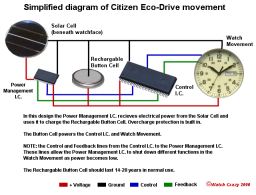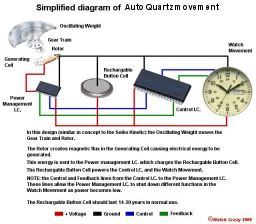 Citizen Eco-Drive Quartz
Movement
|
Very accurate movement. Low parts count makes
movement rugged.
Use of
rechargeable cell allows many extra watch
features and extremely long time on a charge
(up to 500 days).
Least owner
involvement, just wear it in light and it
recharges !
|
All rechargeable cells have a
finite number of charge/discharge cycles and
will eventually have to be replaced. Use of this movement in
single piece, closed back cases means that
the watch has to be serviced by someone who
has the equipment to open these cases.
Cells can be
expensive ($39.00).
|
 Seiko Kinetic Movement
|
Very accurate high quality
movement. Latest models have elaborate
power management which extends charge life up
to 4 years.
A capacitor
(which is what the Kinetic Power Unit
essentially is) has a practically unlimited
life compared to a button cell.
|
Must be worn frequently to keep
the charge up. Not suited to inactive persons.
Occasional
reports of short power unit life.
Use of
capacitor does not provide enough energy
reserve to run many functions.
Power units
may be expensive to replace ($40-$60).
|
 AutoQuartz Movement
|
Very accurate movement. Use of rechargeable
cell allows many extra watch features and
extremely long time on a charge (up to 500
days).
All the
features of a Seiko Kinetic with a much
longer charge life due to use of a
rechargeable cell.
|
All rechargeable cells have a
finite number of charge/discharge cycles and
will eventually have to be replaced. Cells can be expensive
($39.00).
|

